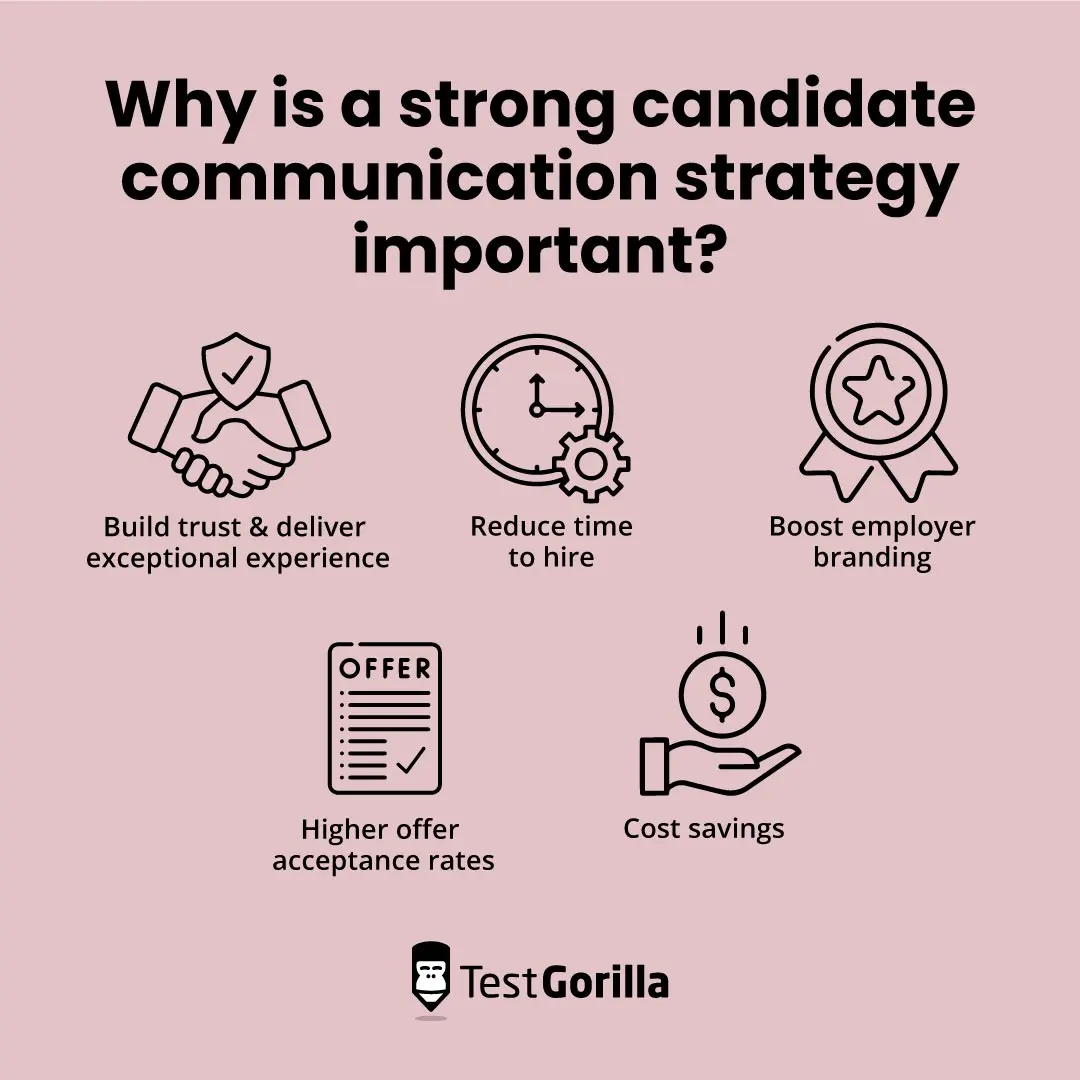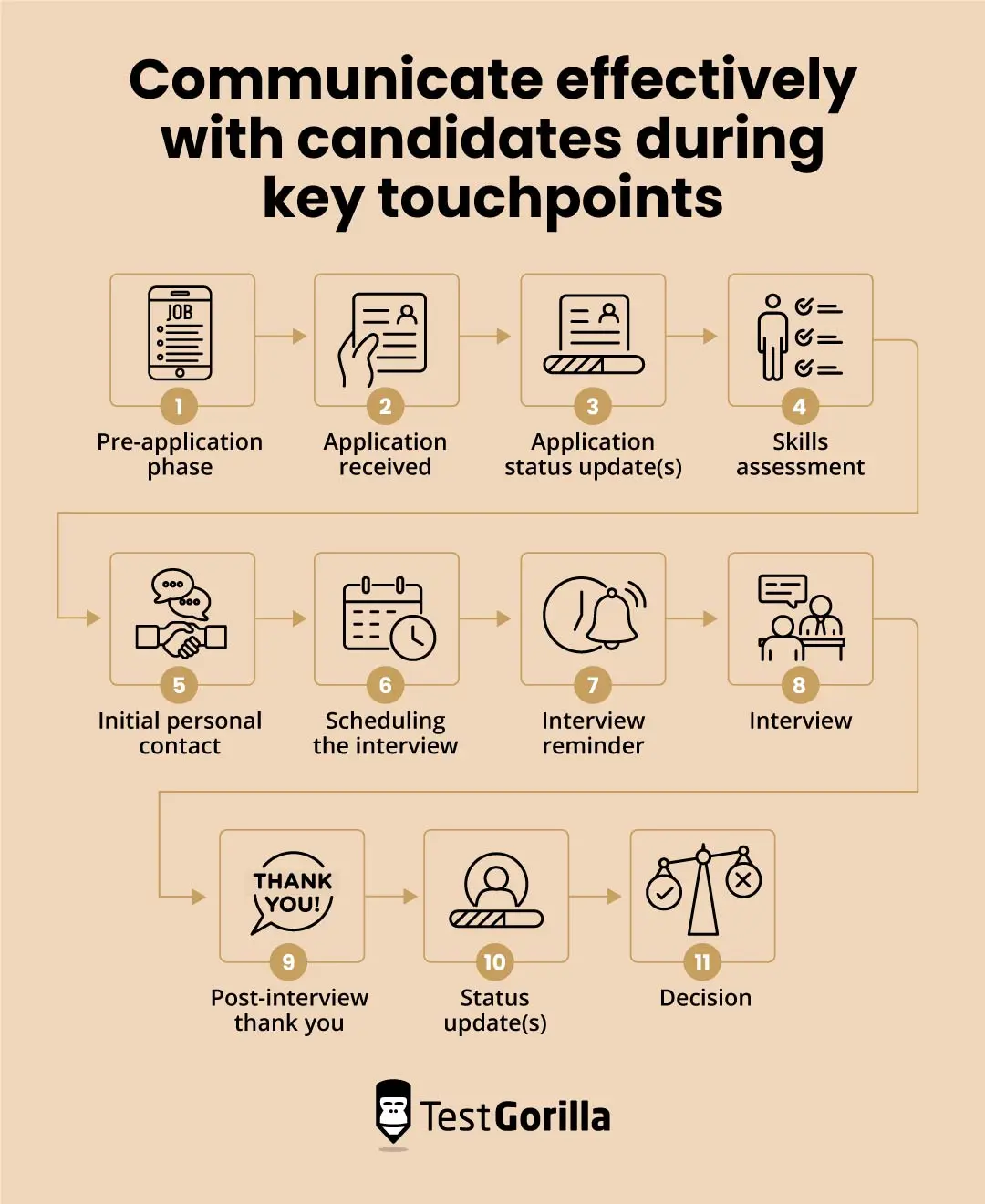Workplace communication is essential – there's no two ways about it, but what about before you make the hire?
Understanding how to communicate with candidates during the hiring process could be the difference between finding your ideal hire and losing the best candidate for the role.
Communication with prospective employees goes deeper than maintaining a professional air to make your company look good. You could miss out on the best candidates purely because of poor correspondence or a delayed job offer.
This guide will show you the step-by-step process of communicating well with your candidates, with explanations of the crucial touchpoints you can customize to your company and specific hiring process.
We’ll also provide a series of quick tips to improve your overall candidate communication strategy.
Let's get to it.
Table of contents
- Why a strong candidate communication strategy is important during the recruitment process
- How to communicate effectively with candidates and prospective employees
- 1. Define and map your key touchpoints.
- 2. Communicate about the hiring process
- 3. Tell them when it’s a no and provide constructive feedback
- 4. Be sincere, upfront, and don’t dodge their questions
- 5. Ask for feedback
- 6. Personalize communication where possible
- 7. Use the right channels
- 8. Provide timely follow-ups
- Stand out from other employers by communicating effectively with candidates
Why a strong candidate communication strategy is important during the recruitment process
Here’s why an effective candidate communication strategy during recruitment is essential in today's competitive job market:
1. Build candidate trust and deliver exceptional candidate experience
When job applicants feel they are kept in the loop and that their needs are being met, they are more likely to trust the employer and have a positive impression of the company. This can lead to a better candidate experience and a higher chance of the candidate accepting the job offer.
According to a survey by Talent Board, 66% of candidates with a positive hiring experience are more likely to refer others to the company, while 72% of those with a negative experience are likely to share their views online.
2. Reduce time to hire
A well-defined candidate communication strategy can help smoothen your recruitment process, reduce the time it takes to hire a new employee, and improve your time-to-hire metrics. In a competitive job market, a quicker hiring process can be a decisive factor in securing top talent.
3. Boost employer branding
The way you communicate with candidates can have a significant impact on your employer brand. Candidates will be more likely to view your company as a desirable workplace if you are known for being responsive and transparent. This can make it easier to attract top talent in the future.
4. Higher offer acceptance rates
Effective communication throughout the hiring process can lead to higher offer acceptance rates. A positive candidate experience through clear and transparent candidate communication can make a lasting impression and increase the likelihood of a candidate accepting your job offer. Meanwhile, a survey showed that 58% of job seekers have declined a job offer due to a bad candidate experience.
5. Cost savings
Poor communication with candidates can result in drop-offs or withdrawals, leading to higher recruiting costs. According to SHRM, replacing an employee can cost six to nine months of their salary in finding and training their replacement.
How to communicate effectively with candidates and prospective employees
The good news is you can take steps to communicate effectively with your candidates during the hiring and selection process. Let's take a closer look at them below.
1. Define and map your key touchpoints.
Every company’s process will be a little different as it depends on your recruitment and selection strategy.
However, the following communication touchpoints represent the typical process. Use this guide as a baseline and customize it to suit your business as needed. For example, you might have trial runs or multiple interview stages.
Most of these touchpoints can be customized using emails, texts, or phone calls. However, the initial contact and the final decision should always be an email or phone call since it’s more professional.
Pre-application phase
Starting communication with prospective employees before the hiring process starts gets your relationship off on the right foot.
So how do you communicate with job candidates who haven’t applied yet?
Individuals who opt-in to receive career-related newsletters or messages asking if you’re hiring should receive a message thanking them for their interest. You can then direct them to any relevant job opening, vacancies, and offers.
Application received
Replying to a candidate right after they apply for a position is one of the most crucial touchpoints.
Job seekers rate promptness in application confirmation nearly as important as how quickly they get a follow-up after an interview when making up their minds to join a company.
Here’s an idea of what to include in your application confirmation:
The name of the applicant and the position they applied for
Confirm that their application has been received
Explain your application process, such as how long it takes and how long until they know if they’ve gone through to the next round
Contact information of the recruiter or hiring manager
Share your company’s culture, including links to websites and social media
Let’s see what that looks like:
To: candidate@example.com
Subject: Your application to [company name]
Hello [first name],
We’ve received your application for the position of [title]. [Short description of the recruitment process].
You can read more about us on our company career page [link to career page] or follow us on social media on [link to social media pages] to get the latest updates.
If you have any questions, you’re welcome to contact me at [telephone number and/or email address].
Regards,
[Your name]
[Signature]
This message reassures candidates that the application was submitted correctly and represents your organization well. You don’t need to send it out manually each time – to speed things up, you could automate the initial confirmation.
Application status update(s)
This is when you let the candidate know that their application is being reviewed.
This step isn’t just about conveying solid communication and representing your company well – it’s also keeping your offer fresh in the candidate’s mind, as they may be pursuing options other than yours.
Mention when you expect to be finished reviewing applications, when and how you plan to assess skills, when you're scheduling interviews, and let them know that you’ll follow up with any news.
Prompt them to contact you if they have questions or comments.
Here’s a quick example:
To: candidate@example.com
Subject: Your application at [company name] for the [title] position
Hi [first name],
How has your week been?
I wanted to update you about the status of your application for the [title] position.
[Hiring manager] is currently reviewing all [applications] and we’re expecting to schedule interviews by [timeframe].
I will contact you as soon as I have any news.
In the meantime, please feel free to reach me via email or at [telephone number and/or email address], if you have any questions or comments.
All the best,
[Your name]
[Signature]
It doesn’t have to be a lengthy update. Simply telling the candidate that his application is in progress is great communication.
Skills assessment
If you’re using a skills testing platform like TestGorilla (and you should, by the way!), invite applicants to take a skills assessment. Explain why you’re interested in testing their skills (for example, to guarantee an objective and fair hiring process) and also which skills you’d like to assess and why.
Outline the next steps and also explain that results will only be used for the purposes of hiring and remain private.
Giving applicants enough context will improve the overall candidate experience and will also boost candidate engagement.
If you’re using TestGorilla, you can directly send out invitations from the platform. The process is infinitely scalable, regardless of whether you need to send 10 or 110 invitations.
Initial personal contact
It’s important to let the candidate know when their application has been approved and that you’d like to move to the next stage.
Here’s some essential information to include:
Tell the candidate that they performed well on the skills assessment and that you’d like to schedule an interview
Ensure they’re still interested in the position
State your preferred interview process and method, such as in-person, phone call, or video call
Mention what you plan to talk about, such as discussing the role in-depth and getting to know the candidate
Give an approximate timeframe for the interview
Once the candidate replies and confirms that they’d like to move forward, you can begin scheduling the exact time.
That leads us to the next point.
Scheduling the interview
After the candidate has confirmed their interest in the position, it’s time to schedule the interview.
The subject line is particularly important as you want the candidate to open this message as soon as possible. Try subject lines like:
Invitation to interview – [company name]
Interview with [company] for [job title]
If your organization conducts multiple interviews, be sure to state which interview this is in the subject as well. Such as “Invitation to Second Interview – [company name].”
Inform them whom they’ll be meeting with and how many people will attend. Tell them how long it should last again – reiterating information isn’t redundant in this context, it’s helpful.
You should include two to three dates you’re available to offer flexibility. Many hiring teams provide a link to an online calendar.
Here’s an example message for scheduling an interview:
To: candidate@example.com
Subject: Invitation to interview – [company name]
Hi [first name],
It’s great to hear you’re still interested in the [title] position.
As part of the next stage, you’ll meet with [department head] and [any additional names]. The interview will last about [timeframe], and you’ll have the chance to discuss the [title] position and learn more about our organization.
Would be available on [range of dates/times]?
[or]
Here’s a link to my calendar so we can schedule a time to talk.
Looking forward to hearing from you,
All the best,
[Your name]
[Signature]
Interview reminder
This message is to refresh the candidate’s memory and ensure they have it penned in their calendar.
There are many reasons a candidate will appreciate a reminder, such as juggling multiple applications and offers, and the simple fact that life can be hectic.
You can also use this opportunity to remind the candidate of anything they should expect or anything they should prepare in advance.
You can also reiterate where the meeting is going to take place and provide a link to directions to your office, or if it’s a video call, include the meeting link again.
Reminding the candidate of the upcoming interview helps prevent interview no-shows. For more tips on this topic, read how to handle interview no-shows and avoid them altogether.
Interview
Yes, it may seem obvious, but the interview itself is a crucial touchpoint during the hiring process.
The first interview strongly represents your organization and makes a lasting impression. This is your chance to show your company’s policies and practices. Ask the right questions and answer them, too.
You can display professionalism, organization, and a modern edge by conducting a structured interview for each candidate. To create your own, take a look at our interview guide template.
At the end of the interview, don’t forget to discuss the next steps, such as when you expect to finish deliberations or trial runs (if your company does them).
Post-interview thank you
Promptly send the candidate a follow-up message thanking them for their time.
It shows courtesy and respect, and it will definitely influence their decision to accept your job offer, should you select them.
You can also mention that it was nice to meet them, bring up the expected decision timeframe again, and let them know they can ask you any questions they have.
The post-interview thank you can be brief, but even a small message is important.
Status update(s)
Updates, as you make your final decision, are particularly important.
“We’re in the final stages of processing candidates and will be contacting you within the week.”
“We have a few more interviews before we can make our final decision. We’ll keep in touch and will most likely finish deliberations in three weeks.”
If a candidate is currently managing several offers, this step will help you save a great hire from potentially going with another company – or from getting frustrated with a lack of communication.
Status updates can also strengthen your company's reputation.
You don’t want to be known as a company that interviews a candidate and leaves them hanging. It gives the impression that you weren’t interested in hiring in the first place. Or that you just don’t care.
Decision
The last touchpoint of communication with prospective employees is the final decision.
When the decision is a “yes,” this will be your formal job offer. When it’s a “no,” this message will be to let the applicant know they didn’t get the job.
Either way, make sure the message is very clear with no room for guessing.
If you’re making a job offer, include as much information as you think the candidate needs to make up their mind. Here are some details to include:
Job title
Working hours
Department
Manager
Salary details
Benefits
Contract length (if applicable)
You should also include company policies, compensation plans, and employment terms.
Be sure to set a specific timeline for when you need to hear the candidate’s final decision.
Here’s an example job offer:
To: candidate@example.com
Subject: Job offer from [company name]
Hello [first name],
We’re very impressed with your background and your interview and would like to formally offer you the position of [title].
This is a [full/part] time position [detail days and hours]. You’ll be reporting to [department head/manager].
We will be offering you [pay range/salary]. You will also have [company benefits, such as health and insurance plan].
Your expected starting date is [date].
Attached are the company policies and compensation plan.
We expect to have your response by [date]. In the meantime, please feel free to contact me should you have any questions.
We are all looking forward to having you on our team.
Best regards,
[Your name]
[signature]
Knowing how to communicate with candidates properly includes hitting these 11 key touchpoints and hitting them fast.
We cannot emphasize enough how important speed is in all correspondence with a prospective employee. How quickly you make contact with a candidate is a crucial deciding factor in whether or not they join your team.
It’s unfortunate that 33% of North American candidates who completed job applications still hadn’t heard back from employers a full two months later.
This is your company’s chance to step up, carve a good employer brand, and differentiate itself in your candidate’s eyes. Even if you don’t select a candidate, make sure to inform them promptly about your decision.
2. Communicate about the hiring process
Communicate your company’s hiring process as often as possible, possibly at every touchpoint.
Transparency is crucial because 67% of job seekers say the transparency of a company’s hiring process is an important factor in whether or not they accept a position.
It takes any mystery out of the equation for candidates and gives them a clear picture of what to expect.
3. Tell them when it’s a no and provide constructive feedback
You should always tell the candidate your decision – even when it’s a “no.”
This is an opportunity to show the candidate respect and display your company’s tact.
This is also a good chance to provide a great candidate with useful constructive feedback. It gives the candidate great actionable insight and promotes a good relationship in the future.
In a 2021 study, when feedback was given to applicants after rejection, their willingness to refer others to the company went up by 24%, and their willingness to maintain or deepen their contact with the employer grew by 36%.
To discover more about this subject, read our article on constructive interview feedback.
4. Be sincere, upfront, and don’t dodge their questions
Be as sincere and candid as you can be during the communication process. Answer as many questions as possible, and if there’s a question you can’t answer, let them know.
Sincerity is highly appreciated by candidates and will definitely make a mark.
5. Ask for feedback
Your candidates are the people most affected by your hiring communication, so their opinions are your best feedback.
Ask how the experience was and where you could improve. You can even do with an anonymous survey.
You can refine your recruitment communication strategy with this knowledge, and most candidates will respect your willingness to improve your recruitment process.
6. Personalize communication where possible
Personalizing communication with prospective employees leaves a strong impression.
Writing out messages to candidates can make your company feel human, although this isn’t always possible. Automated messages can be helpful or outright essential in some cases:
“No” responses for the first round of applications
Connection messages on LinkedIn
However, a “no” after an interview should be personalized to show respect for the candidate and their time.
Try to personalize communication where possible but don’t feel the need to write out each and every email.
Another good example of personalized communication is to address candidates by their names in all communications and reference specific details from their resumes or interviews to show that you value their unique qualifications and experiences.
7. Use the right channels
Use communications channels that are most convenient for candidates. For example, if a candidate prefers to communicate via email, you should send them email updates. If they prefer to communicate via phone, you can call or send them a text message.
Be respectful
Treat candidates with courtesy and professionalism at all times. This means being polite and respectful, even if you are not interested in their candidacy.
8. Provide timely follow-ups
For example, after making a job offer, promptly follow up with candidates to address any questions or concerns they may have about the offer package or benefits.
Here are some additional tips for improving candidate communication:
Use applicant tracking system (ATS) to streamline the process and keep track of candidates' status. Learn how to choose the right ATS.
Leverage automation and use automated email responses to send out quick updates.
Set up a dedicated call center or chat system for candidates to reach out with questions.
Provide feedback to candidates, even if they are not selected for the job.
Celebrate the successes of your new hires and share them with other candidates.
Stand out from other employers by communicating effectively with candidates
Understanding how to communicate with your candidates will improve your hiring strategy and your overall standing in your industry. Candidates will have a better experience, which will influence their final decision and enhance their opinion of your company.
Each touchpoint is important. However, the following are the most essential touchpoints you should not miss:
Application received
Interview status update
Final decision
For more ways to improve your hiring process, read our articles on:
With TestGorilla, you’ll find the recruitment process to be simpler, faster, and much more effective. Get started for free today for bias-free hiring.
Related posts
Hire the best candidates with TestGorilla
Create pre-employment assessments in minutes to screen candidates, save time, and hire the best talent.
Latest posts
The best advice in pre-employment testing, in your inbox.
No spam. Unsubscribe at any time.

Hire the best. No bias. No stress.
Our screening tests identify the best candidates and make your hiring decisions faster, easier, and bias-free.
Free resources
This checklist covers key features you should look for when choosing a skills testing platform
This resource will help you develop an onboarding checklist for new hires.
How to assess your candidates' attention to detail.
Learn how to get human resources certified through HRCI or SHRM.
Learn how you can improve the level of talent at your company.
Learn how CapitalT reduced hiring bias with online skills assessments.
Learn how to make the resume process more efficient and more effective.
Improve your hiring strategy with these 7 critical recruitment metrics.
Learn how Sukhi decreased time spent reviewing resumes by 83%!
Hire more efficiently with these hacks that 99% of recruiters aren't using.
Make a business case for diversity and inclusion initiatives with this data.




















